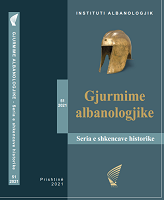MONEDHAT ROMAKE ME SIMBOLE USHTARAKE TË GJETURA NË RAJONIN E PEJËS
THE ROMAN COINS WITH MILITARY SYMBOLS FOUND IN PEJA REGION
Author(s): Naser FerriSubject(s): Museology & Heritage Studies, Regional Geography, Military history, Middle Ages
Published by: Instituti Albanologjik i Prishtinës
Keywords: Roman coins; Dardania; Upper Mesia; Viminacium; military symbols;
Summary/Abstract: In 2021 as a case discovery in Peja was found a Roman coin of the reign of Emperor Gordian III with a portrait of this emperor in avers and with a female figure who personifies the province of Moesia Superior (Upper Moesia) with the attributes of the Roman goddess Victoria in her hand, surrounded on both sides by two figures of a bull and one of a lion, which were the symbols of the legions of VII Claudia and IV Flavia which were moved from Dalmatia to Moesia in 62 and 86 AD and which formed the military crew of Moesia Superior from the I century to the end of antiquity. On the averse are the portraits, names and titles of the emperors Gordian III (225-244), Philip the Arab (244-249) and Trajan Decius (249-251), while on the reverse each coin bears the inscription: PMS COL VIM (Provinciae Moesiae Superioris Colonia Viminacium= Viminacium of the Roman province Upper Moesia) and the signs AN IIII (anno quarto) which also date the coins in question. It is an interesting fact that earlier in the region of Peja were found coins such a coin of the time of the emperor Philip the Arab (244-249) found in Dobrushë and another found in Dresnik from the time of Emperor Trajan Decius (249-251), with which began the period of Roman emperors of Illyrian origin which had continued until the time of Constantine the Great (306-337) and who avoided the rapid destruction of the Roman Empire. All three coins were minted in the years: 242/243, 244/245 and 249/250 AD, respectively belong to the time of the rule of three different emperors but all are minted in the same coin-cutting workshop in the capital of the province of Upper Moesia-Viminacium, which had operated from 239 to in the year 255 AD. In addition to the three coins dealt with here, from this time period is the coin treasure (hidden vault of money) found in 2004 in the Izvore locality between Mitrovica and Zubin Potok consisting of 28 bronze coins minted during the reign of the emperors: Gordian III , Philip the Arab, Philip II , Trajan Decius, Etruscila, Quintus, Trebonianus Galus and Volusianus, 26 of which on the avers carry the portraits, names and titles of the mentioned emperors, while on the reverse have the inscription: PMS COL VIM and a female figure, personifing the province Moesia Superior (Upper Moesia) surrounded on both sides by two figures of a bull and one of a lion. Two other coins on the reverse have the legend PROVINCIA DACIA but it is likely that all these coins were minted in the provincial coinage workshop of Viminacium. Otherwise, in the territory of Upper Moesia, a total of 16 hidden vault of money were found with such coins minted in Viminacium between the years 252/253 AD, which are supposed to have been hidden due to the danger during the civil war that took place at that time or the risk of attacks barbarian tribes. The coin of the Roman emperor Gordian III recently found in Peja, together with the two earlier coins found in this region and the hidden vault (treasaury) of coins from the village of Izvore near Mitrovica and other treasures with the coins of the same type found throughout Upper Moesia (whose main part formed the territory of the former Dardanian Kingdom) are important numismatic documents and historical evidence of the time related to the provincial issues of Roman coins and other historical events of the middle of the III century AD, respectively of the time of the flourishing period of this province, the nucleus of which was the territory of the former Dardanian Kingdom inhabited by the Dardanian people and at the same time regarding the past of the region where the coins were found but also about the creation of an overview regarding the Roman Empire in general at certain historical moments of the time when they were minted and were in use.
Journal: Gjurmime Albanologjike - Seria e shkencave historike
- Issue Year: 2021
- Issue No: 51
- Page Range: 41-60
- Page Count: 20
- Language: Albanian
- Content File-PDF

